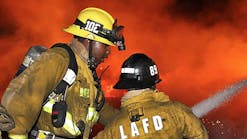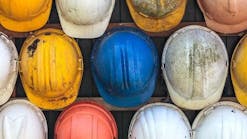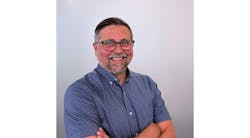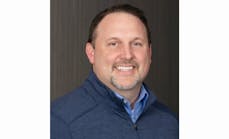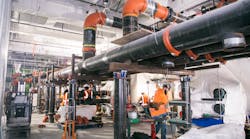By ERIN MILLER, EIT, LEED AP, Southland Industries, Dulles, VA
When it comes to designing a central plant, there are many factors to consider. Not only does the plant need to operate efficiently, but the equipment arrangement needs to be considered from both an initial construction and a future maintenance perspective.
Central plants include multiple trades and disciplines, such as life safety systems, mechanical, electrical, and plumbing equipment, IT infrastructure, pneumatic tube systems, and/or trash chutes to name a few. Working with all of these trades and systems is vital to designing a central plant that will efficiently work for each building’s needs. Although each plant can be designed differently for each unique client, there are three key factors to always consider:
1. Future Maintainability
While the easy way out may be to design a central plant where all the equipment fits, it’s important to keep in mind the facility personnel who will be maintaining the space. Before the design phase begins, meet with the facility’s team to understand what is important to them. Does your client need a central plant that is expandable for future growth? Does the facilities team place high priority on easy access to each piece of equipment? If the central plant needs to expand or have equipment removed and replaced, designing a space that allows for easy transport, either by crane or an adjacent elevator, can go a long way if planned in the early design phases.
2. Redundancy and Reliability
Although each facility is unique, all have critical components. To ensure a backup system is available for any emergency situation, designing for redundancy can increase reliability by duplicating critical functions. To provide a reliable system for the customer, setting up a central plant with valves and miscellaneous components in accessible locations can allow for quick isolation and maintenance. Additionally, designing the plant with spare capacity will allow the building to continue running efficiently in the event of an emergency. Review with the client to determine requirements for redundancy during the early stages of design.
3. Initial Construction
Building the central plant adds a third set of challenges to the design of central plants. The timing and coordination of building the central plant requires a high level of coordination with the installation of the structure. Look for opportunities to collaborate with the steel subcontractor on the installation schedule to allow equipment to be rigged into the building at the safest and most efficient time. Furthermore, plenty of time to complete commissioning and balancing should be factored into the overall schedule to allow for unknown issues to be solved with limited interruptions.
Although each facility is different, understanding how the central plant will need to be designed can positively affect the facility management team and the building’s tenants. A well-designed central plant can eliminate risk for all parties during and after construction and prolong the life of the plant. This is why we strive to collaborate with our clients and the facility personnel on every project to understand their needs and provide a customized and efficient project overall.
A design engineer in the Mid-Atlantic Division of Garden Grove CA-based Southland, the author is charged with generating innovative solutions for building HVAC systems. She has experience in healthcare, commercial, and mission critical work, as well as in managing the field coordination of mechanical systems. Taken from the April 2018 edition of HPAC Engineering magazine, this article first appeared in The Big Room, Southland's thought leadership blog.


